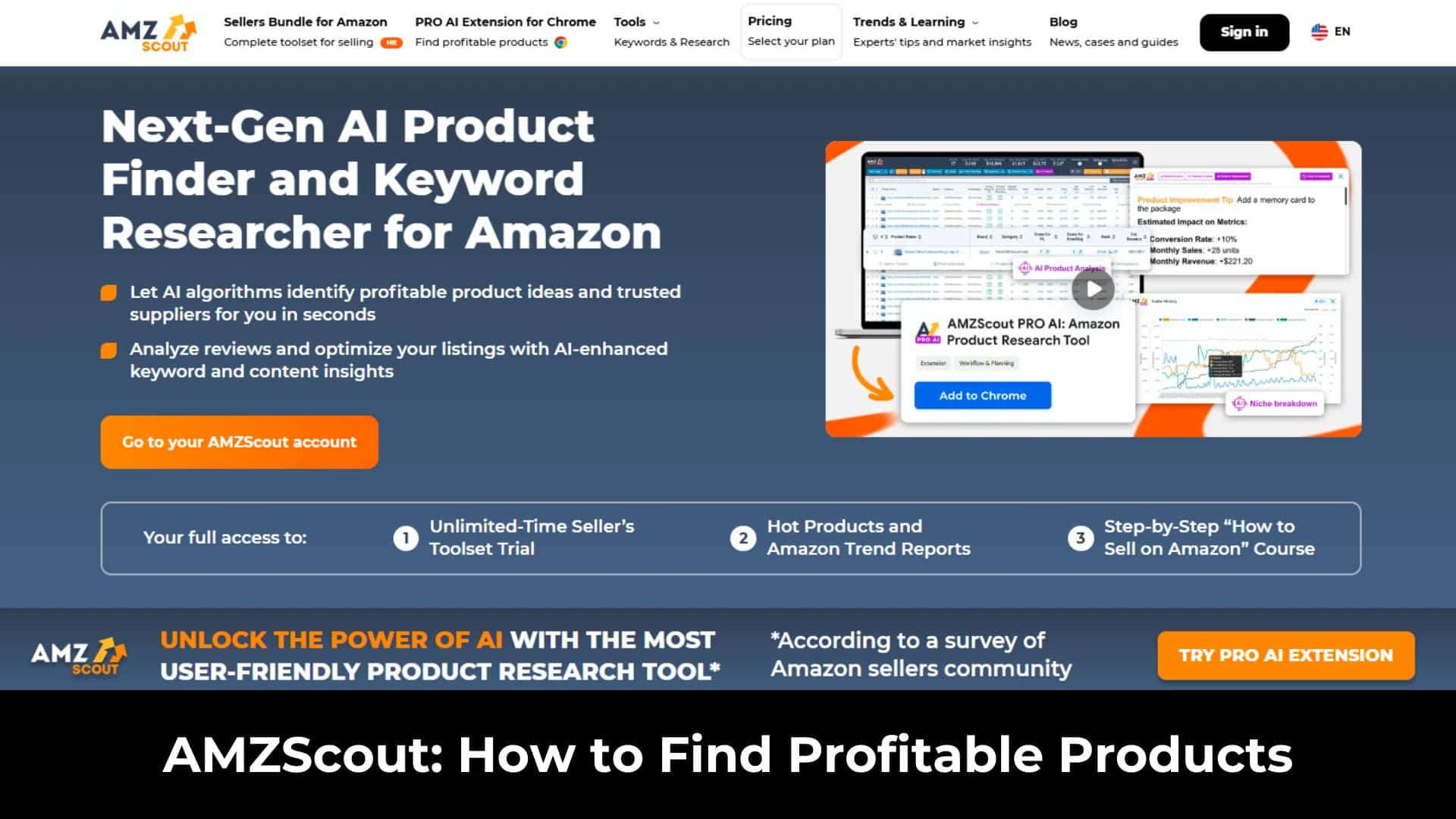If you want to succeed with Amazon FBA, it all starts with one thing: a product that actually makes money.
But with millions of options out there, knowing where to begin can feel overwhelming.
Here’s the truth — there’s no single formula for finding winning products. There are multiple approaches, and each has its own strengths. You don’t have to stick with just one method. Once you understand how each strategy works, you can combine them in a smart way to get better results.
In this post, we’ll walk through 10 proven strategies to help you discover high-potential products — whether you’re launching your first Amazon FBA business or scaling an existing one.
Table of Contents
ToggleStrategy #1: Use Amazon’s Own Data to Find Product Ideas
One of the simplest ways to start product research is to browse directly on Amazon. But if you do it randomly, you’ll quickly feel overwhelmed.
Instead, approach it like a pro: set clear criteria to filter your options. Here are a few common benchmarks that successful sellers often use:
- High demand: Look for products selling at least 300 units per month (about 10 sales per day).
- Low competition: Focus on niches where top-selling products have fewer than 400 reviews — it’s easier to break in.
- Reasonable size and weight: Keep it under 5 lbs and 18x14x8 inches to reduce storage and shipping costs.
- Price range of $30–$70: This sweet spot gives you enough margin to be profitable, while still being affordable for most buyers.
- 4x markup rule: Ideally, the product should cost you only 25% of the retail price — leaving room for FBA fees, ads, and profit.
Of course, there are other filters you can use — like targeting specific categories or analyzing the number of competing sellers. But no matter how sharp your criteria are, manually sifting through Amazon’s massive catalog takes time.
That’s where tools like AMZScout Product Database can help. You can set these filters automatically and scan thousands of products in seconds — turning a slow, manual process into a fast, focused search.
Quickly Build a List of High-Potential Products
If you don’t want to spend hours digging through Amazon manually, you can speed things up with a tool like the AMZScout Product Database. It gives you access to millions of Amazon listings, plus over 16 advanced filters to help you zero in on the right products.
Here’s how to use it:
Step 1: Create an AMZScout account, then open the Product Database tool.

Step 2: Set your product criteria. Click “More Filters” to unlock the full range of options.

You can filter by review count, price range, estimated sales, weight, category, and more.

If you’re not sure where to start, AMZScout offers pre-made filter templates to guide beginners.

Step 3: Choose what type of products you want to focus on.
For example, you can look for:
- Products that launched recently (within the past 2 weeks)
- Products with strong growth (sales up 20%+ in the last 1–3 months)

Step 4: Click “Find Products” to see the results.

Step 5: Build your shortlist.
Sort the results by metrics that matter most to you — like highest estimated revenue or lowest number of reviews.
Example:
Let’s say you filter for products priced between $20 and $70, with fewer than 200 reviews, under 5 lbs in weight, and selling over 300 units per month.
That’s a solid starting point for new sellers — and with the right filters, AMZScout makes product research faster, easier, and a lot more strategic.
Strategy #2: Analyze Product Potential with Amazon AI Tools
Another powerful way to identify winning products is by using the AMZScout PRO AI Extension. This Chrome extension lets you analyze any product directly on Amazon, giving you instant insights into its profitability, sales potential, and fit for your business model.
You can also compare products side-by-side within a niche — making it easier to choose the best opportunity.
Here’s how to use it:
Step 1: Install the AMZScout PRO AI Extension on Chrome.
Sign up for an AMZScout account to activate the tool.
Step 2: Go to Amazon and search for a product you want to analyze.
Enter your keyword, and then click the AMZScout icon in the top-right corner of your browser to open the tool.

Step 3: Evaluate how well the product fits your strategy.
Sort the results by Estimated Sales to see what’s actually selling.
Check the Product Score for each listing. It tells you whether a product is better suited for reselling or private label — so you don’t waste time on the wrong model.
Step 4: Dive deeper into performance. Click on a product, then select Product History to view historical data:

AMZScout will display the data table.
- Sales & price trends – See whether it’s stable or in decline.
- Review growth – Check if sales increases are backed by steady reviews.

Step 5: Run the Profit Calculator.
Enter your product costs (sourcing, FBA fees, etc.), and the tool will show your potential profit per unit.

This step is critical — it helps you decide whether the product is worth your investment.
Step 6: Use the AI to assess risks and opportunities.

Click AI Product Analysis > AI Product Insights to get an AI-generated breakdown of:
- Strengths
- Profit potential
- Red flags and market risks

You can even copy the insights and run them through a translator if needed — making it super accessible even for beginners.
Using AI-powered tools like AMZScout PRO doesn’t just save time — it helps you understand why a product is working. And that’s what really matters if you want to build a long-term business, not just chase the next trend.
Strategy #3: Join Industry Events and Seller Communities
If you want to find truly profitable products, don’t just rely on research tools. Sometimes the best insights come from real conversations with experienced sellers.
That’s why attending webinars, conferences, and seller meetups can be a game changer.
These events give you access to strategies people are using right now to find untapped niches, spot trends early, and evaluate new product ideas before they invest.
Here are some top events worth checking out:
- Prosper Show – One of the biggest Amazon seller conferences in the U.S., focused on scaling and operational excellence.
- Amazon Accelerate – Hosted by Amazon itself, this event highlights the latest tools, features, and seller success stories.
- Global Sources Summit – Perfect for sellers who want to connect directly with suppliers and stay on top of product trends.
You can also watch replays of virtual events hosted by leading software companies:
- Jungle Scout Webinars – Insights from a top Amazon research tool provider.
- Helium 10 Workshops – Live training sessions from one of the most respected names in Amazon tools.
Attending in-person events also opens up another advantage: networking. You’ll meet people who are building brands, running ad campaigns, and solving the same challenges you’re facing.
Sometimes, one conversation with the right person can unlock your next big breakthrough.
Strategy #4: Discover Winning Products Through Keyword Data
One of the most reliable ways to find hot-selling products is to look at what people are actively searching for.
Market demand always leaves clues — and keywords are one of the clearest signals.
Here are a few simple ways to start:
- Use autocomplete suggestions: Start typing a product idea into the Amazon or Google search bar. You’ll see real-time keyword suggestions based on what people are searching most.
- Study product reviews: Customers often repeat certain words or needs in their reviews. These clues reveal what they truly care about — and can spark new product ideas.
- Use keyword tools: Google Trends is great for seeing general search interest. But for Amazon-specific research, tools like AMZScout Keyword Search give you better, more relevant data.
How to use AMZScout Keyword Search for product research:
Step 1: Open the Keyword Search tool inside AMZScout.

Step 2: Enter a seed keyword related to a niche or product (e.g. “t-shirt,” “kitchen tools,” “baby toys”). You can also add filters like minimum search volume or word count.
Step 3: Click Find Keywords to generate a full list of related search terms.

Step 4: Build your list of product ideas.
Focus on keywords with:
- High monthly search volume
- Stable year-round interest (non-seasonal)

Click the chart icon next to each keyword to view the monthly trend. This will help you spot whether the product is evergreen or seasonal.

This approach takes the guesswork out of product research.
If people are consistently searching for something — and the trend is steady — there’s a strong chance that product has real sales potential.
Strategy #5: Outsource Your Product Research to the Pros
You don’t have to do everything yourself.
If you’re short on experience or simply want to save time, outsourcing your product research can be a smart move — especially if you work with the right team.

One trusted service in this space is Sellerhook. They combine a team of product research experts with access to a massive product database and proprietary tools. Based on your criteria, they’ll handpick the most promising product opportunities and deliver a detailed report straight to your inbox.
Instead of taking chances on a random freelancer, working with a vetted service like Sellerhook helps you reduce risk and get clearer, data-driven results.
How to use Sellerhook for product research:
Step 1: Visit Sellerhook’s website and choose a service package.

Step 2: Fill out a short questionnaire.
They’ll ask about your target niche, ideal price range, and any other preferences or requirements.
Step 3: Receive your report.
Within 10 business days, you’ll get a custom product research report via email — complete with product recommendations and performance metrics tailored to your needs.
If you’re planning to start an eCommerce project but aren’t sure where to begin, Sellerhook can give you a solid head start.
Having expert guidance early on helps you avoid costly mistakes, move faster, and choose products with real profit potential.
Strategy #6: Stay Ahead with Expert Trend Reports
Don’t have time to dig through data yourself? You can still stay on top of great product ideas — by leveraging expert-curated trend reports.
When you subscribe to the AMZScout annual plan, you get exclusive access to tools and insights that make product research easier and faster:
- Monthly Amazon Market Reports – Get the latest data, trends, and hot products across key categories.
- 19 Weekly Product Ideas – Handpicked by AMZScout’s in-house research team, based on real market demand.
These insights give you a steady stream of high-quality product ideas — whether you’re launching a new brand or expanding your existing catalog.
If you want a more hands-off approach to product research (without sacrificing quality), the AMZScout annual plan is a smart investment.
It saves you time, reduces guesswork, and helps you focus on what matters most: building a profitable Amazon business.
Strategy #7: Look Beyond Amazon for Product Inspiration
Amazon isn’t the only place to find winning product ideas.
In fact, some of the best-selling items on Amazon first gained traction on other marketplaces.
By keeping an eye on what’s trending elsewhere, you can spot rising products before they become saturated on Amazon.
Here’s how to do it:
Step 1: Check trending sections on other platforms.
Sites like eBay and Alibaba have dedicated pages (e.g. “Trending” or “Hot Products”) that showcase what’s currently popular.
Step 2: Shortlist promising items.
Use your usual criteria — price range, product size, competition level, etc. — to filter out low-quality options.
Step 3: Cross-check those products on Amazon. Search for them on Amazon and evaluate demand using:
- Search rankings
- Number of reviews
- Estimated monthly sales

This strategy helps you spot early trends before they go mainstream on Amazon. Products that are taking off on eBay, Alibaba, or other platforms often make their way to Amazon — and getting in early can give you a serious edge.
Strategy #8: Explore Amazon’s “Best Sellers” Page
One of the quickest ways to spot high-demand products is to browse Amazon’s Best Sellers page.
This page is updated hourly and shows the top-selling items across all categories — based on actual sales data.
Here’s how to use it effectively:
Step 1: Go to the Amazon Best Sellers page and select the category you’re interested in.
Step 2: Drill down into sub-categories to narrow your search.

Step 3: Create a shortlist of products that match your target criteria — such as price range, size, and competition level.
Important reminder:
These rankings reflect short-term trends. A product might be at the top due to a flash sale, ad campaign, or seasonal demand.
So don’t make decisions based on ranking alone.
Instead, combine this method with others — like keyword research, historical sales data, and competitive analysis — to figure out whether the product has long-term potential or it’s just riding a temporary wave.
Strategy #9: Find Product Ideas Through Social Media Trends
If you’re looking for free product inspiration — and want to catch trends before they hit the mainstream — social media is one of the best places to start.
Platforms like TikTok, Instagram, and Facebook often show you what products are catching attention right now — whether it’s through influencer posts or viral videos.
Here’s how to do it:
Step 1: Scan what’s trending.
Look through hashtags, influencer content, and viral videos on TikTok or Instagram. What products are people showing off or talking about?
Step 2: Watch the audience reaction.
Take notes on products that spark engagement. Read the comments to gauge actual interest and buying intent.
Step 3: Search for that product on Amazon.
If only a few sellers are offering it — and the demand looks real — you might have a first-mover advantage. Add it to your product idea list.
You can also use tools like AdSpy to see what products are currently being promoted through Facebook ads — especially those driving traffic to Shopify stores.

This gives you a behind-the-scenes look at what other sellers are actively pushing in the market.

Important note:
Social media is great for inspiration, but it doesn’t provide sales data. So don’t skip validation.
Use tools like AMZScout PRO AI or Keyword Search to confirm whether a trending product has real profit potential and fits your business model.
When used right, social media isn’t just for entertainment — it’s a powerful idea engine.
If you’re trend-aware and move fast, it can lead you to the next big product before your competitors even notice.
Strategy #10: Use AI to Brainstorm Product Ideas
AI is becoming a powerful asset in modern eCommerce — especially when it comes to generating new product ideas.
If you’re unsure where to begin, AI tools like ChatGPT can help you create an initial list of ideas based on your business goals and target niche.
Example:
You could ask ChatGPT:
“Give me product ideas for the kitchen category that sell well on Amazon, under $50.”
And instantly, you’ll get a list of suggestions you can explore further.
Sample Prompt to Try:
You are a product research expert for Amazon FBA. Suggest 10 beginner-friendly product ideas for the U.S. market that meet the following criteria:
- Demand: 300+ monthly sales
- Low to medium competition (under 100 reviews for top products)
- Price range: $20–$70
- Strong profit margin (ROI ≥ 100% after FBA and sourcing costs)
- Improvement potential (design, materials, features, etc.)
- Small, lightweight, easy to ship
- No known patents or trademarks
- Room to expand into a product line or brand
Ask the AI to include:
- Suggested product name
- Recommended improvements
- Estimated sales volume, average review count, average price
- Sourcing tips (e.g. Alibaba manufacturers)
- Legal warnings (if any)
At the end, request a table ranking the 10 ideas by potential.
Bonus Tip:
If you use ChatGPT’s DeepResearch feature (available in the paid plan), it can dig into broader data sources and generate a much more detailed report — ideal if you want to go deeper.
But a quick reminder:
AI is a powerful assistant, not a replacement for real-world data or business instincts.
Some AI suggestions may be outdated, inaccurate, or overlook key market details. Use it to spark ideas — then validate them using real product data, trends, and competitive analysis.
When used alongside the other strategies in this guide, AI can help you approach product research from a fresh, efficient, and more comprehensive angle.
Next step: Combine all 10 strategies — from keyword analysis to social trend tracking — to build a complete product research system that works for you.
Bonus Tip: How to Maximize Revenue After You’ve Picked a Product
Once you’ve found a high-potential product, the next step is to optimize how you sell it.
Here are three simple but powerful strategies top Amazon sellers use to boost revenue and scale faster:
1. Differentiate Your Product from the Competition
If you’re building a private label brand, product improvement is key.
Start by reading 1- and 2-star reviews on competing listings. These reviews reveal what customers don’t like — giving you clear ideas for upgrades.
You can also use the AI Product Improvement feature in the AMZScout PRO AI Extension to get suggestions based on competitor weaknesses and customer complaints.
Then, work with your supplier or manufacturer to implement those improvements. Even small upgrades can lead to better reviews, higher conversions, and more sales.
2. Run PPC Campaigns to Drive Traffic
Pay-per-click (PPC) ads are the fastest way to get your product in front of buyers and boost your organic ranking.
Just make sure to manage your campaigns properly — or you’ll burn through your budget with little return. If you’re new to Amazon Ads, study beginner-friendly PPC guides before launching your campaigns.
As a rule of thumb:
- Products priced between $40–$70 usually have enough margin to support profitable Amazon PPC.
- Products above $100–$140 often allow room to run external ads (like Facebook or Google) while still earning solid profit.
3. Offer Product Bundles to Increase Average Order Value
Creating bundles of complementary products is a great way to boost revenue per sale.
Shoppers feel like they’re getting more value for the price — and you sell more items per transaction. It’s a win-win.
Track performance regularly: monitor sales, click-through rates, conversion rates, and ad spend.
This helps you double down on what works, cut what doesn’t, and keep improving your sales strategy over time.
The product is just the starting point. How you position, promote, and package it is what separates average sellers from top performers.
Final Thoughts…
Choosing the right product to sell on Amazon isn’t about gut feeling.
It’s about carefully evaluating market demand, competition, and profit margins — and making decisions backed by data, not guesswork.
Tools like AMZScout — or expert services like Sellerhook — can make this process much faster and more precise. They give you access to real-time insights so you can act with confidence, not uncertainty.
At the end of the day, success on Amazon doesn’t come down to luck.
It comes from making smart, informed decisions — again and again.














Your writing has a way of making even the most complex topics accessible and engaging. I’m constantly impressed by your ability to distill complicated concepts into easy-to-understand language.
Your writing has a way of resonating with me on a deep level. I appreciate the honesty and authenticity you bring to every post. Thank you for sharing your journey with us.
Your blog is a shining example of excellence in content creation. I’m continually impressed by the depth of your knowledge and the clarity of your writing. Thank you for all that you do.
Wow wonderful blog layout How long have you been blogging for you make blogging look easy The overall look of your site is great as well as the content
Your writing is like a breath of fresh air in the often stale world of online content. Your unique perspective and engaging style set you apart from the crowd. Thank you for sharing your talents with us.
Your articles never fail to captivate me. Each one is a testament to your expertise and dedication to your craft. Thank you for sharing your wisdom with the world.
Your blog is a treasure trove of valuable insights and thought-provoking commentary. Your dedication to your craft is evident in every word you write. Keep up the fantastic work!
Usually I do not read article on blogs however I would like to say that this writeup very compelled me to take a look at and do so Your writing taste has been amazed me Thanks quite nice post
Your ability to distill complex concepts into digestible nuggets of wisdom is truly remarkable. I always come away from your blog feeling enlightened and inspired. Keep up the phenomenal work!
I just wanted to express my gratitude for the valuable insights you provide through your blog. Your expertise shines through in every word, and I’m grateful for the opportunity to learn from you.
I was recommended this website by my cousin I am not sure whether this post is written by him as nobody else know such detailed about my trouble You are amazing Thanks
Thanks I have just been looking for information about this subject for a long time and yours is the best Ive discovered till now However what in regards to the bottom line Are you certain in regards to the supply
Your writing is like a breath of fresh air in the often stale world of online content. Your unique perspective and engaging style set you apart from the crowd. Thank you for sharing your talents with us.
I have been browsing online more than three hours today yet I never found any interesting article like yours It is pretty worth enough for me In my view if all website owners and bloggers made good content as you did the internet will be a lot more useful than ever before
Your blog is a constant source of inspiration for me. Your passion for your subject matter shines through in every post, and it’s clear that you genuinely care about making a positive impact on your readers.
Hi i think that i saw you visited my web site thus i came to Return the favore Im attempting to find things to enhance my siteI suppose its ok to use a few of your ideas
Usually I do not read article on blogs however I would like to say that this writeup very compelled me to take a look at and do it Your writing style has been amazed me Thank you very nice article
Your blog is a breath of fresh air in the often stagnant world of online content. Your thoughtful analysis and insightful commentary never fail to leave a lasting impression. Thank you for sharing your wisdom with us.
Your blog is a breath of fresh air in the often stagnant world of online content. Your thoughtful analysis and insightful commentary never fail to leave a lasting impression. Thank you for sharing your wisdom with us.
Hi Neat post There is a problem along with your website in internet explorer would test this IE still is the market chief and a good section of other folks will pass over your magnificent writing due to this problem
you are in reality a good webmaster The website loading velocity is amazing It sort of feels that youre doing any distinctive trick Also The contents are masterwork you have done a fantastic job in this topic
Your blog has quickly become my go-to source for reliable information and thought-provoking commentary. I’m constantly recommending it to friends and colleagues. Keep up the excellent work!
I loved as much as you will receive carried out right here The sketch is attractive your authored material stylish nonetheless you command get got an impatience over that you wish be delivering the following unwell unquestionably come more formerly again since exactly the same nearly a lot often inside case you shield this hike
I just could not depart your web site prior to suggesting that I really loved the usual info an individual supply in your visitors Is gonna be back regularly to check up on new posts
Your blog is a true gem in the world of online content. I’m continually impressed by the depth of your research and the clarity of your writing. Thank you for sharing your wisdom with us.
I was recommended this website by my cousin I am not sure whether this post is written by him as nobody else know such detailed about my trouble You are amazing Thanks
I have been browsing online more than three hours today yet I never found any interesting article like yours It is pretty worth enough for me In my view if all website owners and bloggers made good content as you did the internet will be a lot more useful than ever before
I do not even know how I ended up here but I thought this post was great I do not know who you are but certainly youre going to a famous blogger if you are not already Cheers
Your blog is a breath of fresh air in the often stagnant world of online content. Your thoughtful analysis and insightful commentary never fail to leave a lasting impression. Thank you for sharing your wisdom with us.
Hi i think that i saw you visited my web site thus i came to Return the favore Im attempting to find things to enhance my siteI suppose its ok to use a few of your ideas
Hi my family member I want to say that this post is awesome nice written and come with approximately all significant infos I would like to peer extra posts like this
I loved as much as you will receive carried out right here The sketch is tasteful your authored subject matter stylish nonetheless you command get got an edginess over that you wish be delivering the following unwell unquestionably come further formerly again as exactly the same nearly very often inside case you shield this hike
I just could not leave your web site before suggesting that I really enjoyed the standard information a person supply to your visitors Is gonna be again steadily in order to check up on new posts
Your blog has quickly become my go-to source for reliable information and thought-provoking commentary. I’m constantly recommending it to friends and colleagues. Keep up the excellent work!
Your writing has a way of resonating with me on a deep level. It’s clear that you put a lot of thought and effort into each piece, and it certainly doesn’t go unnoticed.
Your blog has quickly become my go-to source for reliable information and thought-provoking commentary. I’m constantly recommending it to friends and colleagues. Keep up the excellent work!
I’ve been following your blog for some time now, and I’m consistently blown away by the quality of your content. Your ability to tackle complex topics with ease is truly admirable.
Your blog is a constant source of inspiration for me. Your passion for your subject matter is palpable, and it’s clear that you pour your heart and soul into every post. Keep up the incredible work!
Wow amazing blog layout How long have you been blogging for you made blogging look easy The overall look of your web site is magnificent as well as the content
you are truly a just right webmaster The site loading speed is incredible It kind of feels that youre doing any distinctive trick In addition The contents are masterwork you have done a great activity in this matter
Your blog is a breath of fresh air in the often stagnant world of online content. Your thoughtful analysis and insightful commentary never fail to leave a lasting impression. Thank you for sharing your wisdom with us.
Your blog is a constant source of inspiration for me. Your passion for your subject matter is palpable, and it’s clear that you pour your heart and soul into every post. Keep up the incredible work!
I just could not depart your web site prior to suggesting that I really loved the usual info an individual supply in your visitors Is gonna be back regularly to check up on new posts
Your writing has a way of resonating with me on a deep level. It’s clear that you put a lot of thought and effort into each piece, and it certainly doesn’t go unnoticed.
Your blog has become an indispensable resource for me. I’m always excited to see what new insights you have to offer. Thank you for consistently delivering top-notch content!
I do believe all the ideas youve presented for your post They are really convincing and will certainly work Nonetheless the posts are too short for novices May just you please lengthen them a little from subsequent time Thanks for the post
Your blog is a testament to your dedication to your craft. Your commitment to excellence is evident in every aspect of your writing. Thank you for being such a positive influence in the online community.
Wonderful web site Lots of useful info here Im sending it to a few friends ans additionally sharing in delicious And obviously thanks to your effort
I just wanted to drop by and say how much I appreciate your blog. Your writing style is both engaging and informative, making it a pleasure to read. Looking forward to your future posts!
Its like you read my mind You appear to know so much about this like you wrote the book in it or something I think that you can do with a few pics to drive the message home a little bit but instead of that this is excellent blog A fantastic read Ill certainly be back